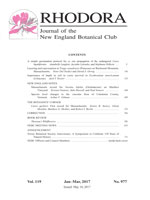The phenomenon of layering in trees involves the production of adventitious roots by low-growing lateral branches and their subsequent reorientation from horizontal to vertical. This study provides the first documentation of layering in any natural populations of eastern hemlock, Tsuga canadensis. Twelve layered hemlock clumps, consisting of 5 to 20 layered branch stems originating from a parent tree, were observed on the upper slopes of Wachusett Mountain in central Massachusetts. Layered hemlocks ranged from 7 to 17 m tall, and several layered branches produced second-generation layers. Harsh growing conditions, slow hemlock growth, and the open habitat associated with small-statured hardwood species and exposed bedrock allowed the hemlocks to retain their lower branches for extended periods of time. Fallen limbs and debris associated with past disturbances pinned these branches to the ground and likely set the stage for layering. The production of physiologically rejuvenated hemlock ramets through the layering process serves to extend the life-span of hemlock genets, expand their spatial dominance of the area, and promote their persistence under stressful growing conditions.
How to translate text using browser tools
1 January 2017
Layering and rejuvenation in Tsuga canadensis (Pinaceae) on Wachusett Mountain, Massachusetts
Peter Del Tredici
ACCESS THE FULL ARTICLE

Rhodora
Vol. 119 • No. 977
January 2017
Vol. 119 • No. 977
January 2017
branch layering
clonal growth
eastern hemlock
physiological rejuvenation
Tsuga canadensis
Wachusett Mountain




